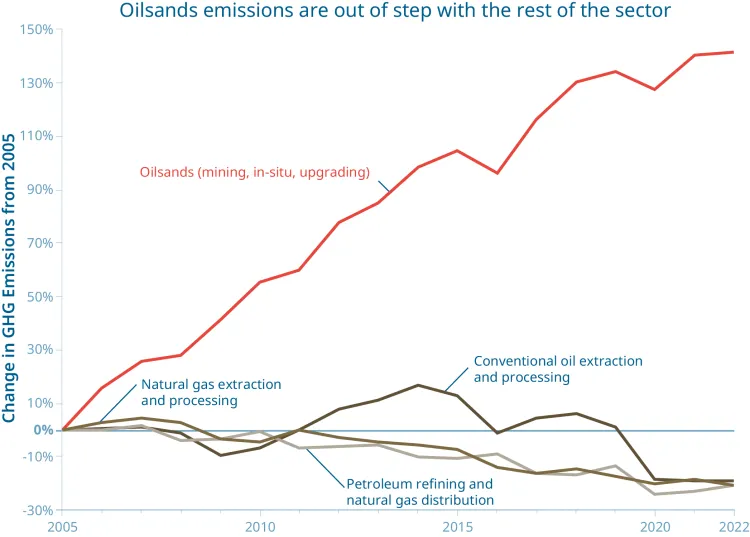CALGARY — JANETTA MCKENZIE, Manager of the Pembina Institute’s oil and gas program, made the following statement in response to the release of Canada Gazette 1 of the federal Oil and Gas Emissions Cap:
“The need to regulate oil and gas emissions is supported by clear evidence. While other economic sectors, and everyday Canadians, have taken steps to reduce their emissions in recent years, emissions from oil and gas production have continued to grow. The companies in this sector are now responsible for almost one-third of Canada’s overall greenhouse gas pollution.
“But there is one part of the oil and gas industry that warrants particular attention: the oilsands. Annual emissions from the oilsands – where six companies account for almost all production – have grown by over 50 million tonnes, an increase of 142 per cent, since 2005.
“Some of those who oppose this regulation have sought to present this issue as a mutually exclusive choice between economic prosperity in Canada, and the fight against climate change. But as our analysis has shown, companies can meet this cap through technological solutions while still growing their production. As the Government of Canada has shown today in its modelling, by 2032 there is a minimal impact to Canada’s GDP as a result of this cap.
“But all of this depends on companies, particularly in the oilsands, being willing to invest in the emissions reduction technologies that are available to them. While we have now witnessed several years of promises and pledges from the oilsands sector to decarbonize its operations, it is still the case that the companies are reluctant to move ahead with projects unless they can be assured of a profitable return on their investments. This is despite billions of taxpayer dollars on offer from the federal and Alberta governments to help pay for close to two-thirds of the upfront cost of carbon capture and storage technology, for example.
“We commend the Government of Canada for consulting with a wide range of stakeholders – including the oil and gas sector, and the oilsands companies – as it has sought to create a regulation that can put the oil and gas industry, and those who work in it, on a path to play a role in Canada’s low-carbon economy of the 2030s and beyond. Reducing emissions from our oil and gas production actually means investing in innovation, skills and technologies to reduce those emissions – a source of prosperity and job creation in provinces like Alberta.
“Although the Government of Alberta and industry groups have in the last few weeks repeatedly cited third-party studies modelling the hypothetical impacts of the emissions cap on the province’s economy, Pembina Institute analysis has found that these studies hinge on the assumption that the industry chooses to take very little meaningful action to reduce emissions, and therefore has no choice but to limit production in the future when the cap actually comes into effect. This is misleading for Canadians. The oil and gas sector has options available to it to futureproof its operations and continue to make an important contribution to Canada’s future economy – but to do so, it must invest in long-promised corporate emissions reduction projects without delay.”
Quick facts
- As of 2022 (latest available data), the oil and gas sector was responsible for 217 million tonnes of carbon dioxide equivalent - or 30.6 per cent of Canada’s overall emissions - annually. This makes oil and gas the single largest source of emissions in Canada, with the oilsands sub-sector alone being responsible for 87 million tonnes, or 12 per cent of Canada’s overall emissions.
- Whereas most sector emissions have declined or remained flat since 2005, the oil and gas sector has seen the largest increase, at 11 per cent.
- As the below figure shows, this increase has been driven by the oilsands – where highly carbon intensive bitumen production has increased, but has not been accompanied by substantive efforts that would reduce absolute emissions. Pembina Institute research has also found that efforts to reduce emissions intensity in the oilsands (amount of carbon dioxide equivalent per barrel) have stagnated and begun to reverse, rising by one per cent since 2018.
- Over the same period (since 2005), all other oil and gas sub-sectors have made progress to reduce emissions. Some of these reductions can likely be attributed to the successful implementation of federal and provincial methane regulations, which have had a greater impact on emissions from conventional oil and gas production, given the scope for methane abatement in those sub-sectors.
- In June 2024, the Government of Canada finalized and passed into law its Carbon Capture Utilization and Storage Investment Tax Credit (CCUS ITC), which covers 50 per cent of companies’ eligible expenses for capture equipment and 37.5 per cent of eligible expenses for transportation and storage equipment — so long as those expenses are incurred before the end of 2030. The passage of the CCUS ITC was a crucial milestone, given that over the preceding three years, Canada’s oilsands companies have cited the finalization of the CCUS ITC as a key requirement for them to commence meaningful investments in decarbonization projects. The Government of Alberta is now accepting applications for pre-approval of its Alberta Carbon Capture Incentive Program (ACCIP), which will provide an additional grant of 12 per cent for new eligible CCUS capital costs.

-30-
Contact
Alex Burton
Communications Manager, Pembina Institute
825-994-2558
Background
Media release: "Oil and gas emissions cap necessary backstop to industry promises"
Report: Waiting to Launch: 2024 mid-year update
Report: All Together Now: A provincial scorecard on shared responsibility to reduce greenhouse gas emissions in Canada
Op-Ed: "Emissions cap needed to spur reductions from highly profitable energy industry"




